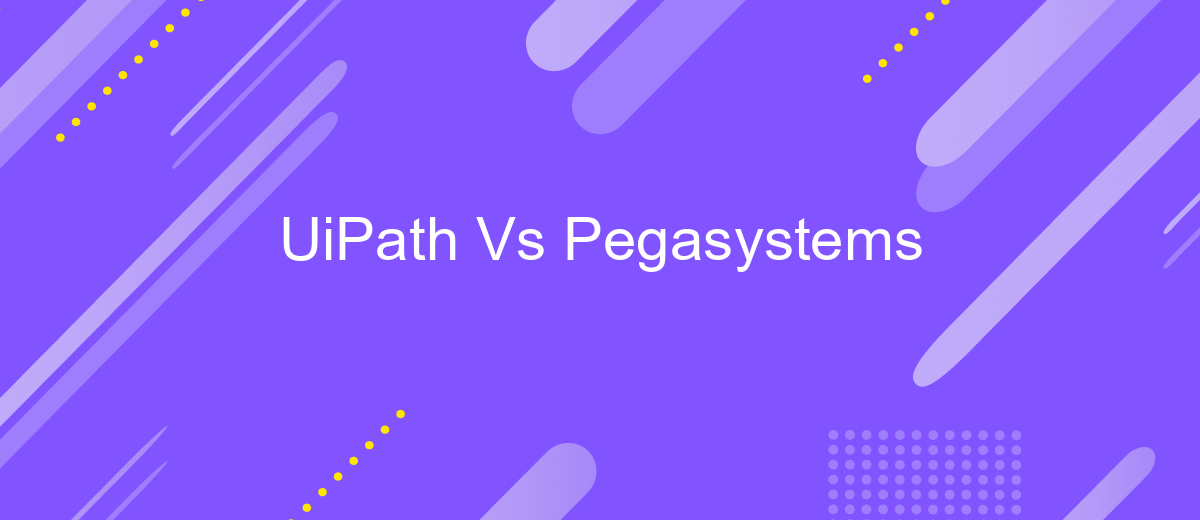UiPath Vs Pegasystems
When it comes to robotic process automation (RPA) and business process management (BPM), UiPath and Pegasystems stand out as leading contenders. Both platforms offer robust solutions designed to streamline operations and enhance productivity. This article delves into a comparative analysis of UiPath and Pegasystems, examining their features, strengths, and potential applications to help businesses make an informed decision.
Introduction
In the rapidly evolving landscape of automation technologies, UiPath and Pegasystems have emerged as two prominent players. Both platforms offer robust solutions for automating business processes, but they cater to different needs and have unique strengths. Understanding these differences is crucial for organizations looking to optimize their operations and achieve efficiency.
- UiPath: Known for its user-friendly interface and extensive library of pre-built activities.
- Pegasystems: Renowned for its powerful case management and decisioning capabilities.
- Integration: Both platforms offer integration capabilities, with services like ApiX-Drive simplifying the process.
Choosing between UiPath and Pegasystems depends on various factors such as the complexity of tasks, scalability requirements, and existing IT infrastructure. While UiPath excels in robotic process automation (RPA), Pegasystems provides a more comprehensive suite for business process management (BPM). By evaluating the specific needs of your organization, you can make an informed decision and leverage the strengths of these platforms to drive business success.
Key Features and Functionality

UiPath offers a robust platform for automating repetitive tasks with its user-friendly interface and extensive library of pre-built activities. It supports a wide range of applications, from desktop to web-based systems, and includes advanced features like AI and machine learning capabilities for intelligent automation. UiPath also provides strong integration options, allowing seamless connectivity with various third-party services and applications. For instance, using tools like ApiX-Drive, businesses can easily set up and manage integrations between UiPath and other software solutions, enhancing workflow efficiency.
Pegasystems, on the other hand, excels in its comprehensive approach to business process management (BPM) and customer relationship management (CRM). Its platform is designed to streamline complex workflows and improve customer interactions through real-time AI and decisioning. Pegasystems offers a highly customizable environment, enabling businesses to tailor the system to their specific needs. Additionally, it supports extensive integrations with other enterprise systems, ensuring smooth data flow and operational coherence. With ApiX-Drive, organizations can further simplify the integration process, connecting Pegasystems with various applications to optimize their business processes.
Benefits and Drawbacks

When comparing UiPath and Pegasystems, both platforms offer distinct advantages and disadvantages that cater to different business needs. UiPath is renowned for its user-friendly interface and extensive library of pre-built automation components, making it an excellent choice for organizations looking to quickly deploy robotic process automation (RPA). On the other hand, Pegasystems excels in providing a comprehensive suite of tools for business process management (BPM) and customer relationship management (CRM), offering a more holistic approach to enterprise automation.
- UiPath Benefits: Easy to use, vast community support, extensive library of pre-built components.
- UiPath Drawbacks: Can become costly at scale, limited to RPA functionalities.
- Pegasystems Benefits: Comprehensive BPM and CRM capabilities, highly customizable.
- Pegasystems Drawbacks: Steeper learning curve, higher initial setup costs.
Both platforms can be integrated with other services to enhance their functionalities. For instance, using ApiX-Drive, businesses can streamline the integration process between UiPath or Pegasystems and other software applications, ensuring seamless data flow and operational efficiency. Ultimately, the choice between UiPath and Pegasystems depends on the specific needs and priorities of the organization.
Pricing and Licensing

When it comes to pricing, UiPath offers a flexible and scalable model designed to cater to businesses of all sizes. They provide a range of licensing options, including a free Community Edition for small teams and educational purposes, as well as enterprise-level plans that offer extensive features and support.
Pegasystems, on the other hand, typically follows a more traditional enterprise software pricing model. Their costs can be higher, reflecting the comprehensive suite of tools and services they offer. Pegasystems often requires a more significant initial investment, which can be a consideration for smaller organizations.
- UiPath: Free Community Edition, subscription-based pricing for enterprise plans.
- Pegasystems: Custom pricing based on enterprise needs, generally higher initial costs.
Both UiPath and Pegasystems offer robust solutions, but the choice may come down to budget constraints and specific business needs. For those looking to integrate various applications and automate workflows seamlessly, services like ApiX-Drive can be invaluable, providing a straightforward way to connect different systems without extensive coding.
Conclusion
In conclusion, both UiPath and Pegasystems offer robust automation solutions tailored to different business needs. UiPath excels in robotic process automation (RPA) with its user-friendly interface, extensive library of pre-built components, and strong community support. It is particularly well-suited for organizations looking to automate repetitive tasks and integrate various software applications seamlessly.
On the other hand, Pegasystems provides a comprehensive suite for business process management (BPM) and customer relationship management (CRM), making it ideal for enterprises seeking end-to-end process automation and customer engagement solutions. While UiPath focuses on task-level automation, Pegasystems offers a broader scope for process optimization. For those looking to enhance their automation capabilities with seamless integration, services like ApiX-Drive can be invaluable, enabling smooth data flow between different systems and applications. Ultimately, the choice between UiPath and Pegasystems depends on the specific requirements and goals of the organization.
FAQ
What are the main differences between UiPath and Pegasystems?
Which platform is better for large-scale enterprise automation?
Can both UiPath and Pegasystems integrate with existing systems?
What kind of support and community resources are available for UiPath and Pegasystems?
How can I automate and integrate processes without extensive coding knowledge?
Do you want to achieve your goals in business, career and life faster and better? Do it with ApiX-Drive – a tool that will remove a significant part of the routine from workflows and free up additional time to achieve your goals. Test the capabilities of Apix-Drive for free – see for yourself the effectiveness of the tool.

